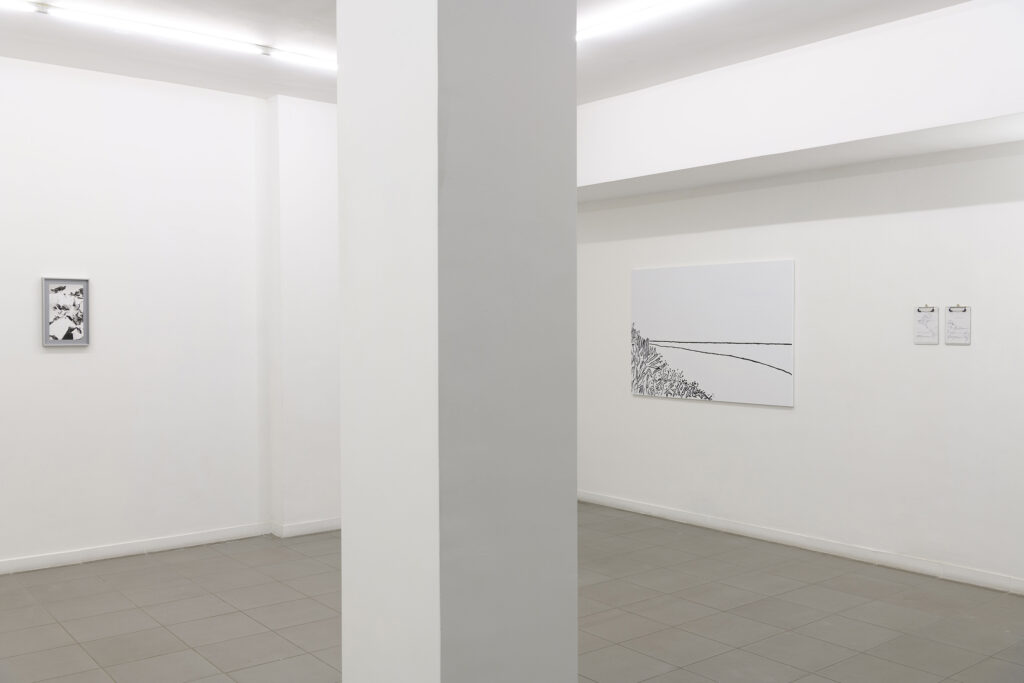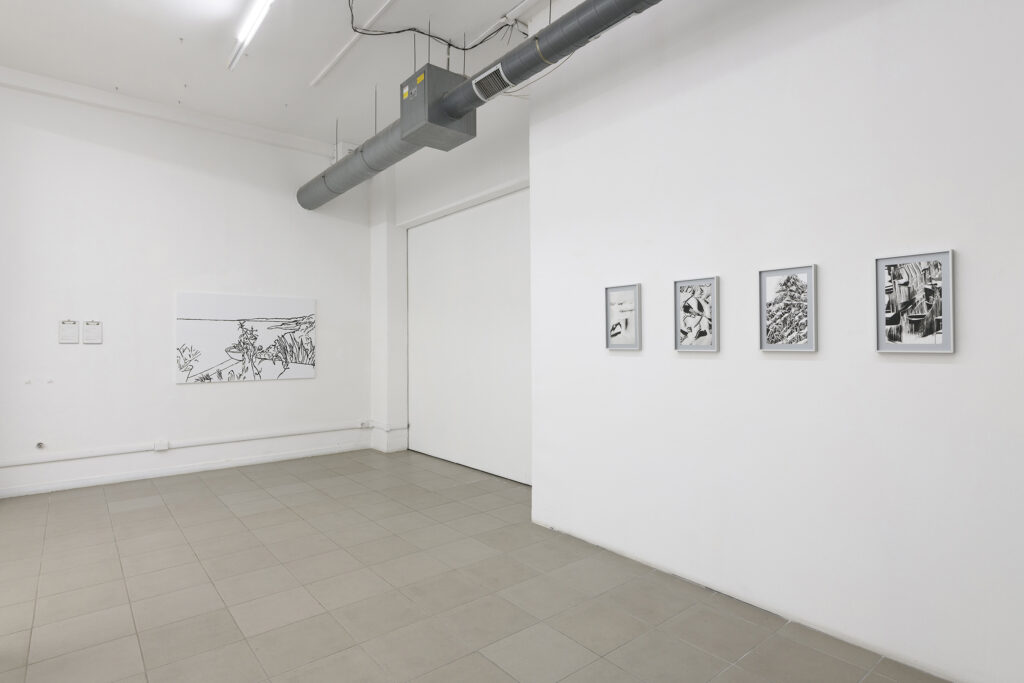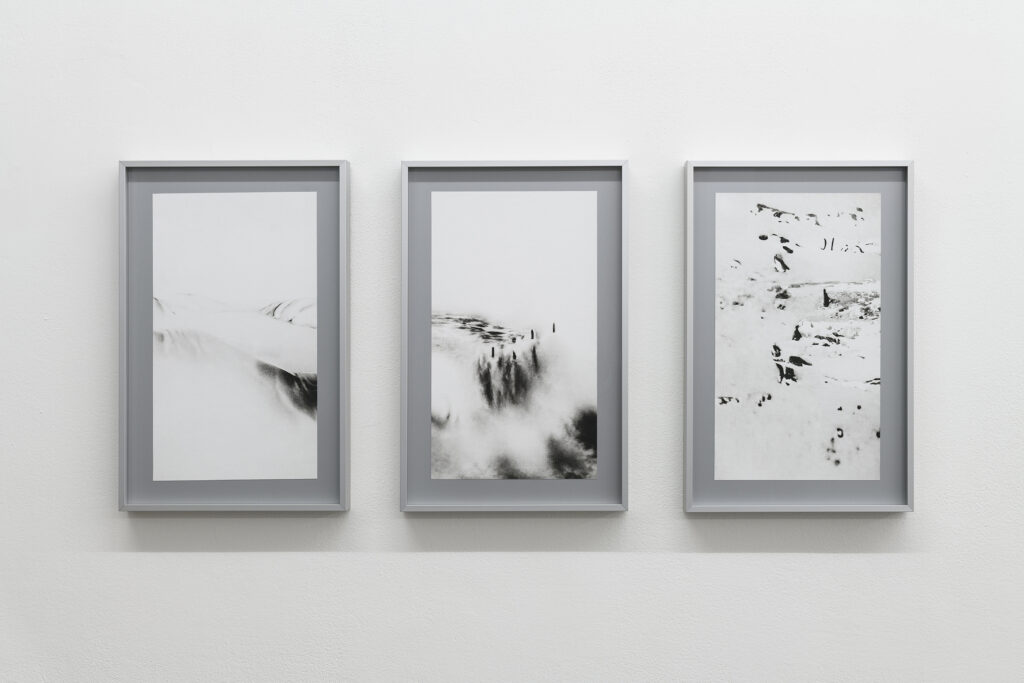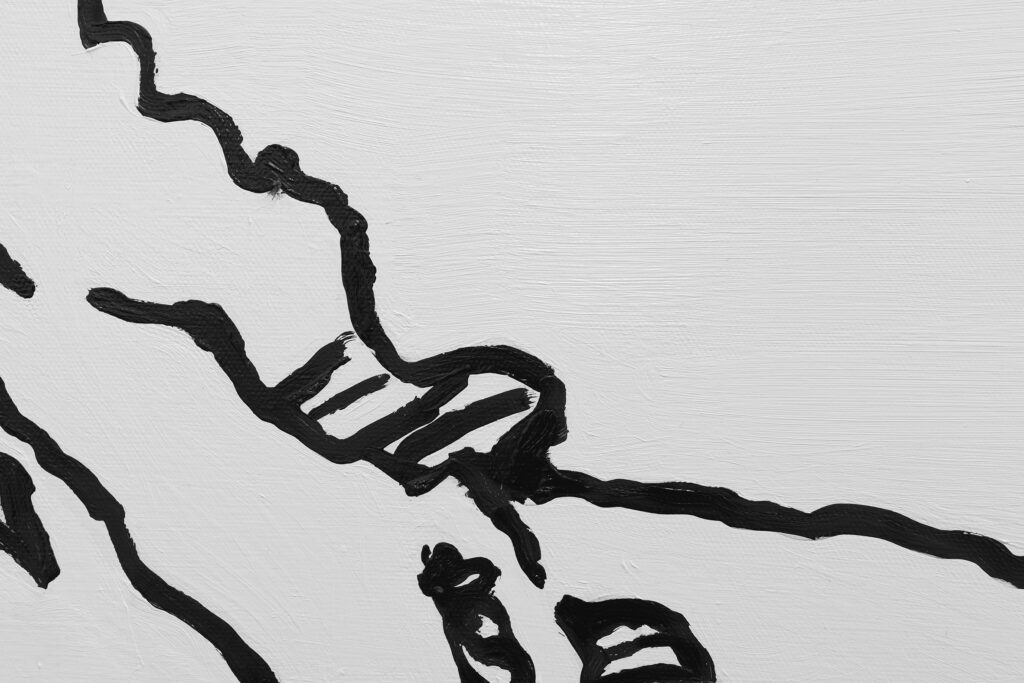Marco Strappato
30.11.2022 – 27.01.2023
Exhibition views

Marco Strappato, Etica, Tecnica e Pathos, 2022, installation view (ground floor), photo by Giorgio Benni 
Marco Strappato, Etica, Tecnica e Pathos, 2022, installation view (ground floor), photo by Giorgio Benni 
Marco Strappato, Etica, Tecnica e Pathos, 2022, installation view (ground floor), photo by Giorgio Benni 
Marco Strappato, Etica, Tecnica e Pathos, 2022, installation view (ground floor), photo by Giorgio Benni 
Marco Strappato, Etica, Tecnica e Pathos, 2022, installation view (basement), photo by Giorgio Benni 
Marco Strappato, Etica, Tecnica e Pathos, 2022, installation view (basement), photo by Giorgio Benni
Works

This place is really nowhere (I – II – IV), 2022, photopolymer etching on Laurier paper 300 mg, mounted on aluminium, with aluminium frame, 42,5 X 27,5 cm, photo by Giorgio Benni
This place is really nowhere (VIII – VII), 2022, photopolymer etching on Laurier paper 300 mg, mounted on aluminium, with aluminium frame, 42,5 X 27,5 cm, photo by Giorgio Benni 
This place is really nowhere (III – V – X – XII – VI), 2022, photopolymer etching on Laurier paper 300 mg, mounted on aluminium, with aluminium frame, 42,5 X 27,5 cm, photo by Giorgio Benni 
Orizzonte e altre linee (I), 2022, oil on canvas, 150×100 cm, photo by Giorgio Benni
Orizzonte e altre linee (I), 2022, oil on canvas, detail, photo by Giorgio Benni 
Orizzonte e altre linee (II), 2022, oil on canvas, 100×150 cm, photo by Giorgio Benni 
Orizzonte e altre linee (III), 2022, oil on canvas, 150×100 cm, photo by Giorgio Benni 
Orizzonte e altre linee (IV), 2022, oil on canvas, 100×150 cm, photo by Giorgio Benni 
Appunti sulle marine (I – II), 2022, drawing on paper, A5 aluminium paper holder, 24 x15 cm, photo by Giorgio Benni
Appunti sulle marine (V – VI – VII – VIII), 2022, drawing on paper, A5 aluminium paper holder, 24 x15 cm, photo by Giorgio Benni 
Seagulls, 2022, wood, plaster, actual size, photo by Giorgio Benni
The Gallery Apart is proud to announce Etica, Tecnica e Pathos (Ethics, Technique and Pathos), the new solo show by Marco Strappato in the gallery spaces. True to an idea of art that cannot exclude the environment, the artist enriches his investigation on the landscape with suggestions from the natural world and with the several human interpretations given by the different cultural fields, from art to architecture, from photography to music and technology.
The title of the exhibition pays homage to an album by the Italian band “CCCP – Fedeli alla linea” titled “Epica Etica Etnica Pathos” (Epic Ethics Ethnic Pathos). This is not a coincidental homage, considering the recording modalities and the images accompanying the album. The recording was performed live on an abandoned farmhouse in the countryside of the province of Reggio Emilia. The band took advantage of the natural echo of the domestic environments, and they settled in the villa throughout the recording. This supports the main role played by the landscape, assumption that Strappato places at the basis of his poetics, also in a domestic version and at the service of another form of art, music. The photographs of the album cover, included as numbered copies, were shot by Luigi Ghirri, a reference point for Strappato who has already drawn on his photos for a series of artworks displayed in the gallery for the exhibition Au-delà.
As he gives his personal reinterpretaion of the title, Strappato elides Epic and replaces Ethnic with Technique, in order to adapt the message to his own vision. To the artist, ethics is inextricably linked to the landscape that is so constantly damaged though it is so in need of care to preserve its intact beauty. The technique corresponds to Strappato’s artistic approach, such a deep-rooted component in his art-making that it soars to an independent line of investigation, in the service of, but often parallel to, that of landscape. For the word Pathos, we can resort to the definition provided by the dictionary: the power to evoke intense feelings and sympathy, aesthetically or emotionally. Nothing could be more in line with the artist’s intentions.
In Etica, Tecnica e Phatos, Strappato uses different media to investigate the topics. Drawing on Werner Herzog’s suggestion (We are surrounded by worn-out images, and we deserve new ones), Strappato presents This place is really nowhere, a series of photoengravings created by using conventional images (landscape stock photos originally spread as smartphone backgrounds) and reprocessed to such an extent that the subject is unrecognizable. Before the spectator’s eyes, the final – ambiguous though evocative – images morph into mental places that, though they suggest the original landscapes, bring to life mysterious fragments of lunar landscapes, imaginary waterfalls or abstractions that evoke pieces of the history of art or paths of the human psychology. The title draws on the claim of the IBM advertising campaign in 1987, when for the first time the developers created a computer-generated mountain in CGI very similar to a real mountain.
Orizzonte e altre linee (Horizon and other lines) is a series of paintings where the artist creates synthetic images generated starting from the horizon line to build the final image is built. The material used is an archive of iconic postcards and prints of Italian coastal landscapes collected by the artist. It is not a survey of the stunning landmarks; each image represents an overall view that feeds off metonymies. It is not by chance that the artworks are white, crossed only by sharp black brushstrokes. The white colour suspends any temporal reference, consistent with the spectator’s own imagery, whereas the powerful simplicity of the painted line highlights the memories that the images can evoke. The series of works is a concentration of emotions through a path of identification and recognition in a familiar, though rare, landscape, which is at time recognizable but made archetypical by the obliterating power of the two colours and which is unequivocally Italian.
Appunti sulle marine (Notes on the seascapes) is the title chosen for a further series of drawings created on unused documents to register the entry of works of art into galleries. Besides the evocation of the passage of time expressed by the obsolescence of the documents now replaced by digital archives, Strappato invites to reflect on the mechanisms that regulate the spreading of the works of art and the relationships between art and market, underlining the force of the artwork that can convey the poetry of a landscape even when it is only drawn on a simple entry document.
Finally, to underline the aura pervading the exhibition thanks to the gracefulness of the artist to interpret the influence of the natural over the artificial, the only three-dimensional element featured in the exhibition, a couple of seagulls made of wood and chalk and titled Seagulls, descends from the ceiling. Although they are placed in the neutral space of the gallery and not in their natural environment, the two sculptures remind us that the landscape cannot suit the needs of men only, as it is lived by creatures that represent the environmental values and should remain its beneficiaries.
The Gallery Apart è orgogliosa di annunciare Etica, Tecnica e Pathos, la nuova personale di Marco Strappato negli spazi della galleria. Fedele ad un’idea di arte che non può prescindere dall’ambiente, l’artista arricchisce la sua ricerca sul paesaggio di spunti che arrivano tanto dal mondo naturale quanto dall’interpretazione che l’uomo ne dà nei diversi campi della cultura, dall’arte all’architettura, dalla fotografia alla musica fino all’uso della tecnologia.
Strappato titola la mostra rendendo omaggio ad un album del gruppo “CCCP – Fedeli alla linea” dal titolo “Epica Etica Etnica Pathos”. Un omaggio non casuale, tenuto conto delle modalità di incisione e della scelta delle immagini poste a corredo dell’album. La registrazione avvenne in presa diretta in una casa colonica abbandonata nella campagna reggiana. Il gruppo sfruttò l’eco naturale degli ambienti domestici e si stabilì nella villa per tutto il tempo di registrazione. Ecco confermata la centralità del paesaggio, assunto che Strappato pone alla base della sua poetica, anche in versione domestica e al servizio di un’altra arte, la musica. Quanto alle immagini utilizzate per la cover dell’album e inserite in esemplari numerati al suo interno, si tratta di scatti di Luigi Ghirri, per Strappato un riferimento già in passato esplicitato in una serie di opere esposte in galleria in occasione della mostra Au-delà.
Nel fornire la sua personale reinterpretazione del titolo, Strappato accantona l’Epica e sostituisce la Tecnica a Etnica, così da adattare il messaggio alla sua specifica visione. Etica è per l’artista materia inestricabilmente legata al paesaggio, così costantemente sfregiato e così invece bisognoso di cura per mantenerne intatta la bellezza. Tecnica corrisponde all’approccio all’arte di Strappato, elemento così radicato nel suo agire artistico da assurgere ad autonomo filone di indagine, al servizio ma spesso in parallelo a quella sul paesaggio. Per Pathos basta la definizione da dizionario: capacità di suscitare un’intensa emozione e una totale partecipazione sul piano estetico o affettivo. Nulla potrebbe essere più aderente alle intenzioni dell’artista.
In Etica, Tecnica e Pathos Strappato declina i temi proposti utilizzando diversi media. Aderendo al suggerimento di Werner Herzog (We are surrounded by worn-out images, and we deserve new ones), Strappato presenta This place is really nowhere, una serie di fotoincisioni realizzate partendo da immagini convenzionali (fotografie di stock di paesaggi originariamente veicolate come sfondi di smartphones) rielaborate al punto da rendere irriconoscibile il soggetto. Le immagini finali, ambigue ma evocative, all’occhio dello spettatore si trasformano in luoghi mentali che, pur mantenendo echi dei paesaggi iniziali, danno vita a misteriosi frammenti di paesaggi lunari, a fantastiche cascate o ad astrazioni che alludono a pezzi di storia dell’arte o ai percorsi della psicologia umana. Il titolo riprende il claim per la campagna pubblicitaria dell’IBM del 1987 in cui per la prima volta gli sviluppatori crearono attraverso l’uso del computer l’immagine di una montagna in CGI in tutto simile ad una montagna reale.
Orizzonte e altre linee è una serie di dipinti in cui l’artista dà vita a immagini sintetiche nate a partire dalla linea dell’orizzonte, attraverso la quale si viene a costruire l’immagine finale. Il materiale di partenza è un archivio di cartoline e stampe collezionate dall’artista, immagini iconiche di paesaggi costieri italiani. Non si tratta di una ricognizione alla ricerca delle bellezze dei luoghi; ogni immagine risponde ad una visione complessiva che si alimenta per metonimie. Non a caso le opere sono bianche, attraversate solo dalla nettezza del nero della pennellata. Il bianco sospende ogni riferimento temporale, assecondando il ricorso dello spettatore al proprio immaginario personale, mentre la semplicità potente della linea dipinta mette a fuoco ogni possibile ricordo che le immagini riescono ad evocare. La serie di opere vuole essere un concentrato di emozioni attraverso un percorso di identificazione e di riconoscimento in un paesaggio che è familiare ma rarefatto, che è a volte riconoscibile ma reso archetipico dal potere obliterante della bicromia e che in ogni caso è inequivocabilmente italiano.
Appunti sulle marine è il titolo scelto per un’altra serie di disegni, questa volta realizzati su documenti inutilizzati di entrata di opere d’arte nelle gallerie. Al di là dell’evocazione del passaggio del tempo stante l’obsolescenza di documenti ormai soppiantati dagli archivi digitali, Strappato invita a riflettere sui meccanismi che presiedono alla veicolazione delle opere d’arte e sui rapporti tra arte e mercato, sottolineando la forza dell’opera che può restituire la poesia di un paesaggio anche se disegnato su un banale foglio di archiviazione.
Infine, a sottolineare l’aura che pervade la mostra grazie alla delicatezza con cui l’artista interpreta l’influenza del naturale sull’artificiale, dall’alto soffitto della galleria scende l’unico elemento tridimensionale in mostra, una coppia di gabbiani in legno e gesso a cui Strappato ha dato il titolo Seagulls. Le due sculture, seppur collocate nello spazio neutro della galleria e non nel loro ambiente naturale, ci ricordano che il paesaggio non è ad uso e consumo dell’uomo ma è abitato da creature che dei valori ambientalisti sono testimoni e devono restarne beneficiari.
share on